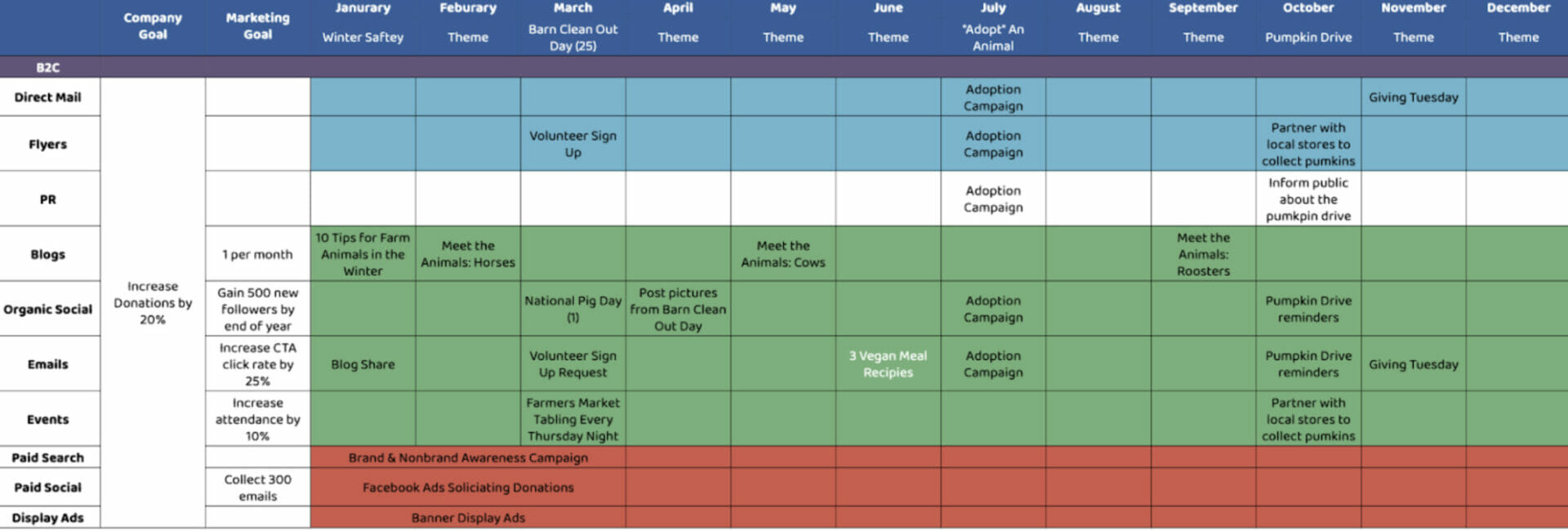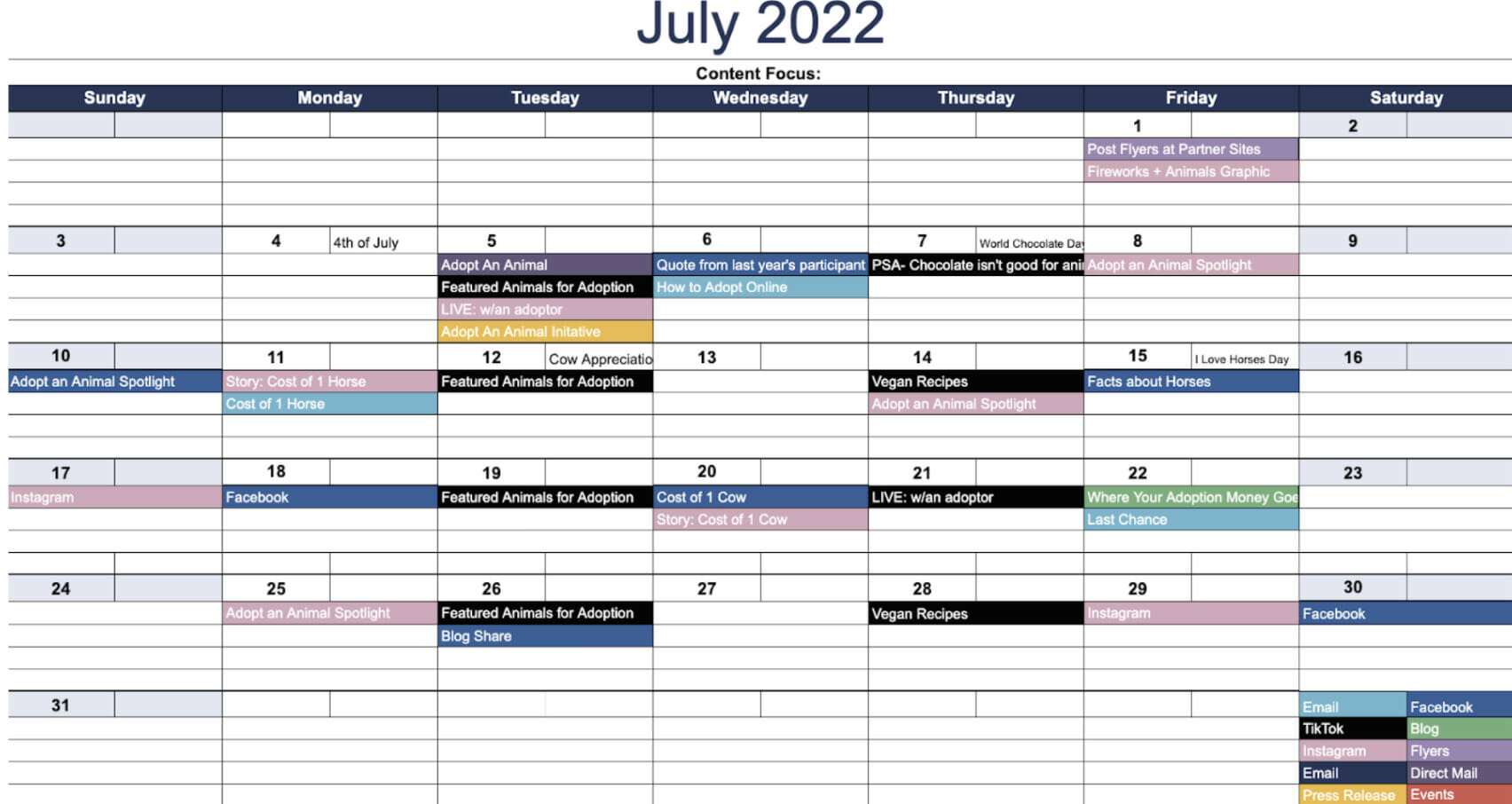How to Create a Nonprofit Marketing Strategy & Content
How to Create a Nonprofit Marketing Strategy & Content
What is Content?
Content, in terms of marketing, is material used to portray a topic through a variety of mediums or marketing channels. Content can come in many forms, such as video, graphics, and “copy,” the words that go into each marketing material. Essentially, content is everything you produce for your nonprofit such as emails, fliers, website pages, and social media posts.
Content Must Tie into Overall Goals
Unfortunately, most nonprofits have limited time and staff, causing them to throw random pieces of content out there. While the content might be topical to the nonprofit, having a content strategy that ties it all together is crucial to the success of your marketing and overall goals. If you map out your content strategy, you can identify what is working and what. Then, you can avoid spinning your wheels when you try to achieve your mission. Therefore, a nonprofit’s content strategy needs to tie into the overall goals.
For example, if a nonprofit’s goal is to increase donations by 20%, the person in charge of content and marketing needs to identify ways to assist. If the nonprofit has historical data, take a look at each marketing campaign from the past 12 months. Did the direct mail campaign result in a lot of donations? How about the email campaign with an easy online donation tool? The email marketing campaign yielded 350 donations, while the direct mail only brought in 50. Once you identify which marketing channels work best for the nonprofit, you can create a content strategy and set smaller marketing goals by medium to support the overall goal.
In this scenario, email marketing was the successful medium for the nonprofit. Therefore, the organization set another goal to increase the number of emails in their database. However, the nonprofit has not done the research yet. It is unknown how many emails are needed to reach the goal of increasing donations by 20%. There are variables that may make it hard to specify how many emails are needed to add to the database. If the nonprofit is brand new or you want to test out some new mediums, then no worries. The steps below will help everyone create a solid content strategy.
Steps to Create a Nonprofit Content Strategy
- Research Similar Nonprofits & Audit Your Content
Researching is the first step in setting specific marketing goals and a content strategy. Research similar nonprofits in your sector and your community to see what is performing well and what isn’t. Maybe you run a nonprofit that helps farm animals, and there is a similar nonprofit two states over that is excellent on TikTok but struggling on LinkedIn. Take that research and use it as a guide to not put so much effort into a LinkedIn strategy. (By the way, you don’t have to do it ALL! Being successful at a few things is better than being mediocre at all the things). Don’t forget to research industry benchmarks for email click-through rates and social media engagement rates. You can use these to help set goals as well!
Once you’ve researched outside your organization, look inward and start auditing your marketing mediums. Don’t just look at what was published or released. Check the cloud or computer storage for unused content pieces from former employees. Maybe there is a half-written blog you could expand upon or a list of topics someone made but never got to. Make sure to study the donor data you have on past marketing campaigns.
Continuing with the example above, dig deep into the email campaign that received 350 donations. Do we know who received a campaign email? Was it past donors or a new list? How many total emails did you send vs. the 350 that took the time to click through and donate? What was the average donation? Once you think through the answers, you can calculate how much to grow your email list.
Research Findings Example:
35% of emails (350/1,000) donated an average of $25.
20% increase of $50,000 = $10,000 / $25 average donation = 400 donors needed to reach goal
400 donors /.35 (rate of emailees that donated) = 1,143 new emails needed
- Identify Where Your Target Audience Is
With the research finished, you now understand who your target audience is. Next, you need to identify where they are most active and what types of content they prefer.
Marketing Channels (aka Mediums):
- Direct Mail
- Social Media
- Website (includes blogs)
- Digital Ads
- Billboards
- Radio
- Television
- In-person Events
- Press Releases
- Search (aka Google Ads)
- Podcasts
- Webinars
Types of Content:
- Written
- Video
- Pictures
- Graphics
- Audio
You can identify these by looking at your target audience’s demographics, past interactions, and research from similar nonprofit organizations. If the target audience is an adult aged 18-25 with an income over $50K and who likes farm animal rescues, you would probably find that the types of content this person prefers are videos, pictures, and graphics over just audio or written content.
- Map Out Content by Month & Channel
Now that you’ve identified where your target audience is and the best communication style, it’s time to put it together with your research and map out the content strategy. First, compile all of the main campaigns. Think of events like annual events and campaigns. Then, think of the different themes, “national days of,” and holidays related to your cause (I.E. National Pig Day was March 1, 2022). Next, use this handy marketing strategy calendar created to help you start mapping out your content by channels and months.

This marketing strategy calendar is filled in with some sample ideas for our continuous farm animal rescue example to show you how to get started. Simply save a copy of the document onto your own Google Drive or download it to your computer before making changes. Then feel free to add, delete, or rearrange as needed.
Note – on the first tab labeled “YEAR strategy,” column C is for the marketing goals that will help a nonprofit reach its overall goal from column B. You should now be able to make an educated, reasonable goal for each channel that would help with the overall goal of the nonprofit.

The second tab, “Monthly Calendar,” is more of the standard content calendar or social media calendar you see online. Many tools like Pardot and Hootsuite have calendars built in However, keep in mind that these platforms do have some limitations.
The third tab, entitled “Content Doc,” is where you can create the copy and keep track of every single piece of content by day, with multiple items each day having their own line.
The beauty of an all-encompassing online content strategy and calendar is that it is always accessible to your team and easily editable. Nonprofit staff can have multiple roles. Therefore, using a cloud-based document to edit together in real-time allows you to divide and conquer based on who’s in charge of which campaigns. You can also engage volunteers and board members who might have a knack for video editing or blogging.
- Assign Content Creation to Team
All nonprofits vary in terms of size and skill of staff members. If your nonprofit doesn’t have a dedicated marketing team member (or even if it does), assign content creation to the entire team based on knowledge and skill sets. Once you have the basic structure in place and know the main highlights for each month or quarter, gather the team together and assign specific tasks. There are plenty of ways to divvy up content creation, so choose what works best for you, but remember to have an assigned editor that checks for spelling and a consistent tone of voice.
The Three Rs
Remember that you don’t have to always create new content. You can repromote, refresh, and repurpose content you’ve made in the past!
- Repromote
- Did you write a blog last year about a popular topic? Take the link and post it on your social media channels or blast it out in an email.
- Refresh
- Notice that the nonprofits’ paid social ads experienced a dip in performance? Refresh the ads with updated photos or a simple copy change to increase people’s interest.
- Repurpose
- Did the most recent Facebook Live Q&A session receive some thought-provoking questions to which you think others should know the answers? Grab some quotes and pop them into a social media graphic. You can also write a blog about them.
Analyze Results
Once you get the content strategy in motion, you need to figure out a consistent time to track the results of each piece of content so that you can adjust the strategy as time goes on. A best practice is to test a specific channel (and vendor if you are doing paid ads) for at least three months. That means if you run a paid social campaign on Facebook, you need to give it three months before deciding to cancel or tweak the ad. Remember to compare your results against the industry benchmarks you researched monthly. (HINT- Most companies that analyze standards group all nonprofits together, so take it with a grain of salt.) In reality, a small farm animal rescue with fewer but highly engaged social media followers will perform better than a large blood bank with thousands of followers who are not engaged.
Reality Check
As you know, the world of nonprofits is constantly changing, so be ready to adjust your strategy and tweak your content calendar as you go! Don’t be afraid to reshare relevant third-party content such as news articles about your cause or a picture that a volunteer tagged you in if you need to fill a gap – just don’t make it a habit. Remember, it’s better to take the time to plan things out on a monthly or quarterly basis and be able to move items around rather than scramble at the last minute to produce some content or go a week without posting anything.
This blog post is courtesy of Uncommon Good.
The post How to Create a Nonprofit Marketing Strategy & Content appeared first on Nonprofit Hub.









Leave a Reply